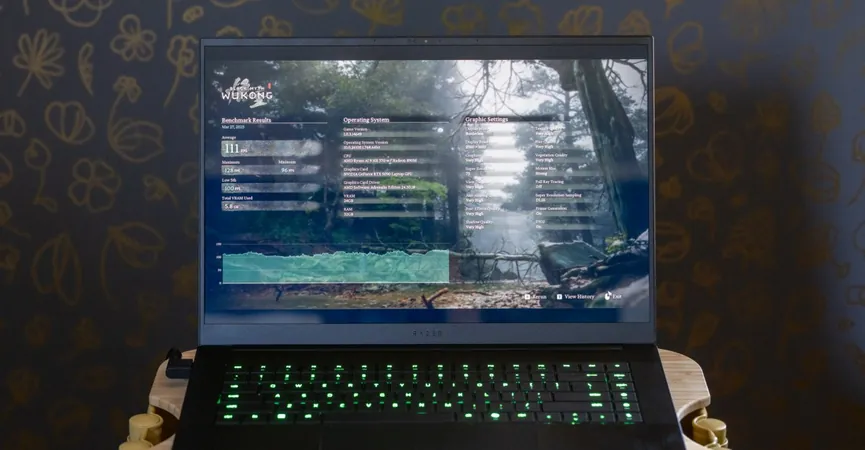
Nvidia RTX 5090 Mobile GPU Review: Is it Truly the Future of Gaming Laptops?
2025-03-28
Author: Jacques
Introduction
Nvidia's 50-series mobile GPUs, particularly the flagship RTX 5090, are making waves in the gaming laptop market, but not without a few challenges. With a rocky start for the desktop versions due to quality control issues and performance concerns, the RTX 5090 aims to stand out in the crowded mobile gaming arena, primarily through improved efficiency.
Testing Experience
My testing of the RTX 5090 was conducted on Razer's latest Blade 16 laptop, which Nvidia has chosen to showcase its new mobile powerhouse. However, my initial experience was marred by some technical hiccups, including graphical anomalies and frequent blue-screen crashes. After receiving a replacement unit, I was able to delve deeper into the performance of the GPU. The early signs indicate a modest performance upgrade when compared to the mobile 4090, particularly in features like DLSS and Multi Frame Generation rather than sheer raw processing power.
Specifications and Performance
One significant upgrade in the RTX 5090 is its impressive 24GB of GDDR7 VRAM, a notable step up from the 16GB GDDR6 of its predecessor. This new GPU also packs more robust Tensor cores and an enhanced hardware video encoder, all while maintaining the same 175W thermal design power (TDP). These upgrades theoretically translate to better performance in specific benchmarks, with a reported 13% improvement in Geekbench scores and a 14% boost in the 3DMark Time Spy benchmarks at a resolution of 2560 x 1440.
Real-World Gaming Tests
In real-world gaming situations, I tested the RTX 5090 with titles like *Cyberpunk 2077* and *Black Myth: Wukong* at both 2560 x 1600 on the Blade 16 and 4K resolution on an Alienware monitor. The most substantial performance gain appeared in *Cyberpunk 2077* without enabled features like DLSS or ray tracing, where the 5090 outperformed the 4090 by 24%. However, engaging features like ray tracing and DLSS 4 diminishes that lead to just a 5% difference. When utilizing 2x frame generation, the 5090's lead over the 4090 expands to 14%, showcasing the importance of these technologies in modern gaming.
Efficiency and Power Consumption
The performance numbers show that with the right settings, the 5090 holds an advantage but loses some of its luster when more advanced graphical features are activated. In *Black Myth: Wukong*, a less forgiving title for GPU testing, the performance difference was marginal, reaching a maximum of 111 fps at 2.5K with DLSS compared to 104 fps for the 4090. This slight edge emphasizes that while the 5090 has improvements, they may not be significant in every game.
One area where the RTX 5090 shines is its efficiency. Benchmark tests indicated that it has a power draw that is 20 to 29% lower than the 4090, which could potentially improve battery life during gaming sessions on the go. Additionally, the efficiency advantages lower heat output, allowing for a more comfortable gaming experience without overheating the device.
Pricing and Conclusion
Prices for laptops equipped with the RTX 5090 start at around $4,000, with the Razer Blade 16 configuration I tested priced at a whopping $4,499. For those considering a new gaming laptop, the investment in a machine with the RTX 5090 might seem steep, especially when considering the availability and performance of the RTX 4090, which may be found at more competitive price points during discounts.
As the gaming landscape continues to evolve, the true potential of the RTX 5090 and its various capabilities surrounding DLSS and Multi Frame Generation will need further exploration. I’m particularly eager to test the RTX 5080 in the coming weeks, which may deliver an optimal balance between price and performance for eager laptop gamers.
Stay tuned for ongoing updates as we continue to evaluate the RTX 5090 and its impacts on mobile gaming in the months ahead!









 Brasil (PT)
Brasil (PT)
 Canada (EN)
Canada (EN)
 Chile (ES)
Chile (ES)
 Česko (CS)
Česko (CS)
 대한민국 (KO)
대한민국 (KO)
 España (ES)
España (ES)
 France (FR)
France (FR)
 Hong Kong (EN)
Hong Kong (EN)
 Italia (IT)
Italia (IT)
 日本 (JA)
日本 (JA)
 Magyarország (HU)
Magyarország (HU)
 Norge (NO)
Norge (NO)
 Polska (PL)
Polska (PL)
 Schweiz (DE)
Schweiz (DE)
 Singapore (EN)
Singapore (EN)
 Sverige (SV)
Sverige (SV)
 Suomi (FI)
Suomi (FI)
 Türkiye (TR)
Türkiye (TR)
 الإمارات العربية المتحدة (AR)
الإمارات العربية المتحدة (AR)